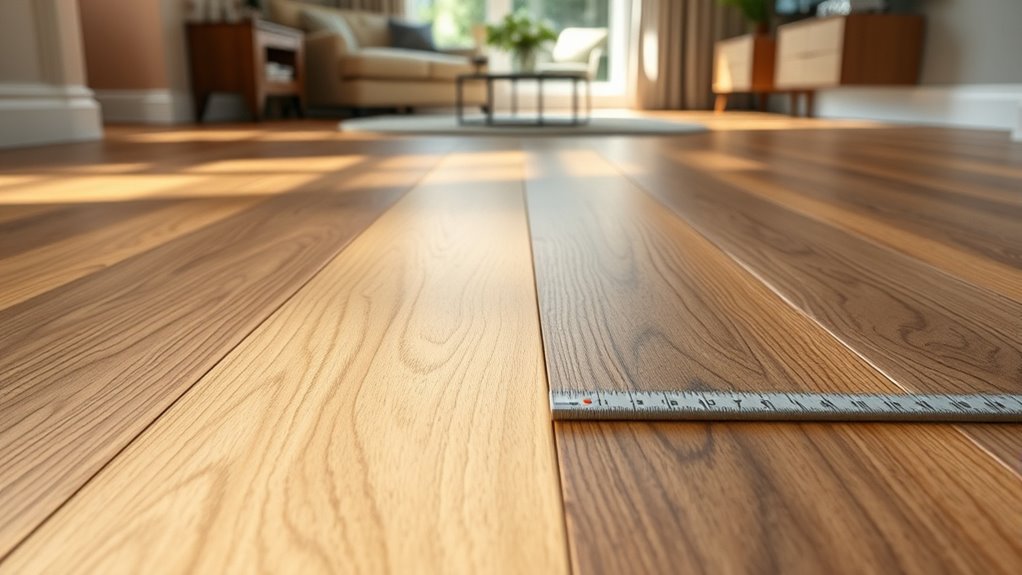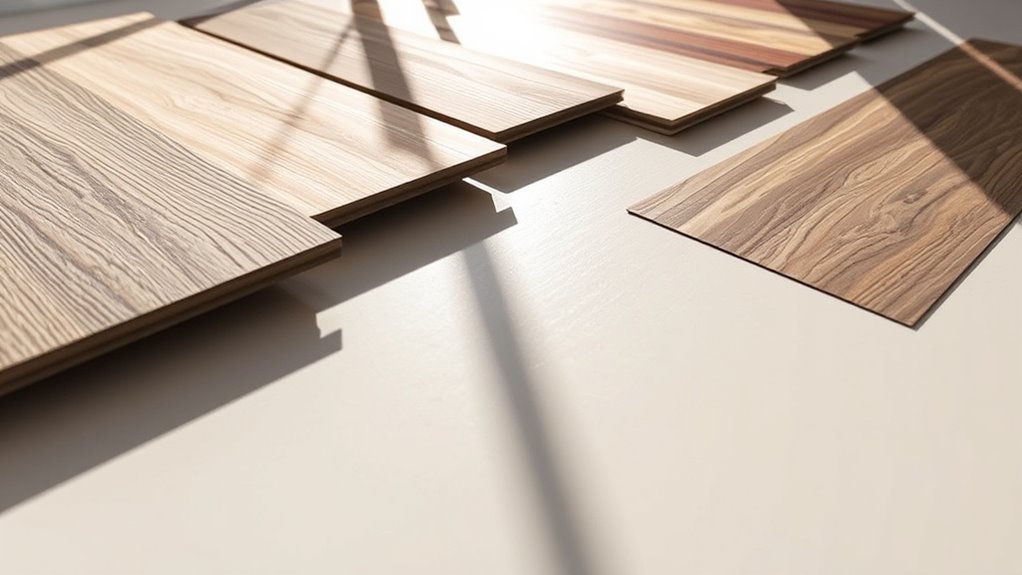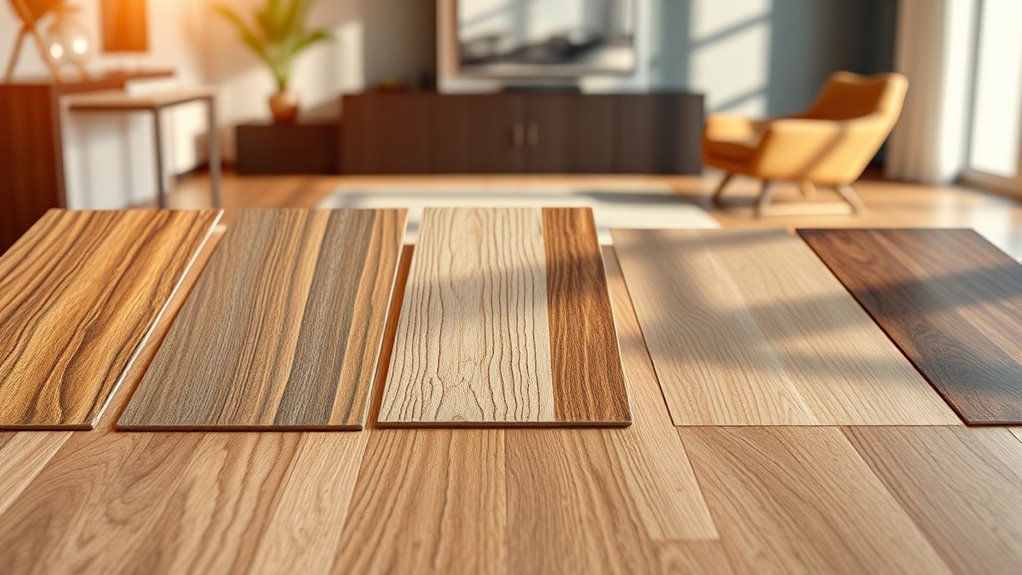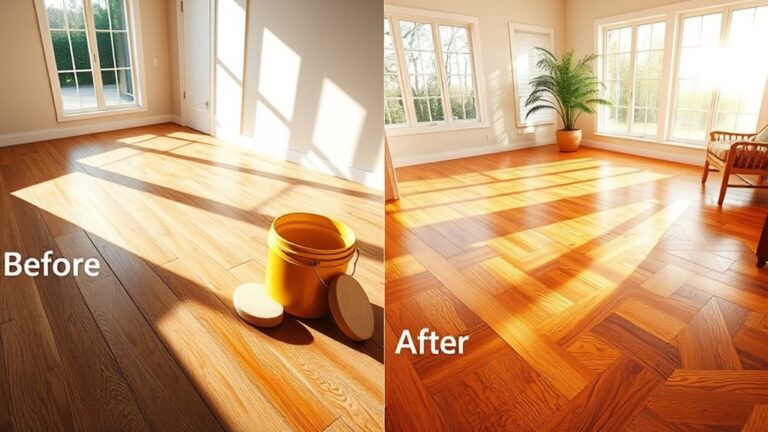LVP flooring typically ranges from 2mm to over 8mm thick. Thicker planks offer better durability, sound insulation, and comfort, making them ideal for high-traffic or uneven subfloors. Thinner options work well for smooth, controlled environments but may wear faster. Your choice should balance traffic, subfloor type, and budget for the best lifespan and performance. Understanding these factors guarantees you pick the right thickness tailored to your specific needs and installation challenges.
Understanding LVP Flooring Thickness

Thickness is a critical factor in luxury vinyl plank (LVP) flooring that directly affects its durability, comfort, and overall performance. When you evaluate LVP types, thickness plays a pivotal role in resistance to wear and impact, influencing how long your floor will last under daily use. Thicker planks generally offer better noise absorption and a more comfortable underfoot feel, enhancing your freedom to move confidently across the space. Additionally, thickness impacts how you approach LVP maintenance; thicker floors can better withstand cleaning methods without damage. Understanding the relationship between thickness, material layers, and surface wear will empower you to select an LVP product that aligns with your lifestyle demands, ensuring your flooring investment provides enduring value and freedom from frequent repairs or replacements.
Common Thickness Ranges for LVP
Most luxury vinyl plank flooring options fall within a thickness range of 2mm to 8mm, with variations tailored to specific performance needs. When exploring an LVP thicknesses overview, understanding these common thickness ranges is essential to match your desired LVP flooring types with functional requirements. Here’s a clear breakdown:
- 2mm–3mm: Ultra-thin options, ideal for light residential use or over existing floors.
- 4mm–5mm: The most popular range, balancing comfort and durability for moderate traffic.
- 6mm–7mm: Premium thickness providing enhanced sound absorption and stability.
- 8mm+: Heavy-duty commercial-grade planks designed for maximum resilience and longevity.
How Thickness Affects Durability

Three key factors determine how well your LVP flooring will stand up to daily wear: its core thickness, wear layer, and overall construction. A thicker core enhances structural integrity, resisting dents and impacts more effectively, which directly extends your flooring’s lifespan. The wear layer, typically measured in mils, is vital for abrasion resistance—thicker wear layers mean better protection against scratches and scuffs. When choosing your LVP, consider that manufacturers often link thickness to LVP warranty terms; a more substantial thickness usually correlates with longer warranty periods, reflecting confidence in durability. Proper LVP maintenance will further maximize performance, but thickness fundamentally sets the baseline for resilience. Selecting the right thickness empowers you with durable flooring that demands less upkeep and offers greater freedom from premature replacement.
Impact of Thickness on Comfort and Sound Insulation
While durability is essential, you’ll also want to take into account how LVP flooring thickness affects comfort and sound insulation. Thicker LVP enhances both comfort levels and sound absorption, creating a more pleasant living environment. Here’s how thickness impacts these factors:
- Increased thickness provides greater cushioning, reducing foot fatigue and improving overall comfort.
- Thicker layers absorb more impact noise, minimizing sound transmission between floors.
- Enhanced sound absorption reduces echo, making rooms feel quieter and more private.
- Ideal thickness balances comfort and acoustic performance without compromising structural integrity.
Choosing the right thickness gives you freedom to enjoy a quieter, more comfortable space. Understanding these technical benefits helps you select LVP flooring that truly complements your lifestyle.
Installation Considerations Based on LVP Thickness

When selecting LVP thickness, you need to assess how it interacts with your subfloor, as thicker planks can better accommodate minor imperfections. Additionally, the thickness influences the installation method; for example, thinner LVP often requires a more stable, level substrate and specific adhesive techniques. Understanding these factors guarantees a secure, long-lasting floor performance.
Thickness Impact on Subfloor
Because LVP (luxury vinyl plank) flooring varies in thickness, the condition and preparation of your subfloor must be carefully matched to guarantee proper installation and durability. Thicker LVP demands a more robust subfloor for stability and subfloor compatibility, while thinner planks require impeccable moisture management to avoid warping. To promote peak performance, consider these factors:
- Assess subfloor flatness; thicker LVP tolerates minor imperfections better.
- Verify moisture levels; thinner LVP is more sensitive to subfloor moisture.
- Reinforce subfloor rigidity as thicker planks exert greater stress.
- Implement moisture barriers when installing over concrete or damp areas.
Thickness and Installation Methods
Though LVP thickness influences your choice of installation method, understanding how each thickness interacts with different techniques is critical for ensuring a secure, long-lasting floor. Thinner LVP, typically 2mm to 3mm, suits floating installations but demands precise subfloor preparation and specialized installation tools for locking mechanisms. Thicker planks, 4mm to 6mm, accommodate glue-down or click-lock techniques more effectively, providing enhanced stability and sound insulation. When using glue-down methods, heavier thickness requires stronger adhesives and careful moisture barrier application. Conversely, floating installations benefit from thicker LVP’s dimensional stability, easing expansion gap management. Selecting installation techniques aligned with your LVP’s thickness guarantees peak performance and durability. Equip yourself with the right installation tools—such as tapping blocks and spacers—to maintain plank integrity and secure fit during installation.
Thickness and Subfloor Requirements
Although the thickness of LVP flooring often ranges between 2mm and 8mm, selecting the appropriate thickness is crucial to confirm compatibility with your subfloor. Different subfloor types—concrete, plywood, or existing vinyl—demand specific thicknesses to guarantee stability and durability. You’ll also need to assess moisture considerations, as thicker LVP can better resist subfloor moisture but may require additional underlayment for ideal protection.
Choosing the right LVP thickness ensures stability, durability, and moisture resistance tailored to your specific subfloor type.
Here’s what to evaluate:
- Concrete subfloors often need thicker LVP (5-8mm) to mask imperfections and manage moisture.
- Plywood subfloors work well with moderate thickness (3-6mm) for flexibility and support.
- Existing vinyl may allow thinner LVP (2-4mm) if even and in good condition.
- Always test moisture levels; high moisture demands thicker, moisture-resistant options.
Choosing the right thickness safeguards your flooring’s longevity and performance.
Choosing Thickness for Different Rooms
When selecting LVP thickness for different rooms, consider the specific demands each space places on the flooring. High-traffic areas like kitchens and hallways benefit from thicker LVP, typically 5mm to 8mm, to withstand constant wear and potential impacts. For bedrooms or low-traffic rooms, thinner options around 3mm to 4mm provide adequate durability while allowing more flexibility in design style choices. Remember, your room usage directly influences the ideal thickness, balancing performance with comfort. Additionally, thicker LVP often enhances sound insulation and underfoot feel, which might be a priority in living rooms or media rooms. Tailor your thickness choice to both the functional needs of your space and its aesthetic goals, ensuring your flooring complements the design style without compromising on resilience or comfort.
Cost Implications of LVP Thickness
Understanding the cost implications of LVP thickness is essential for making an informed flooring investment. When evaluating your options, a clear cost comparison based on thickness can guide your budget considerations effectively. Here’s what to focus on:
- Thicker LVP usually demands a higher upfront cost due to increased material density and durability.
- Thinner options might save money initially but could require earlier replacement or more maintenance.
- Installation expenses can vary; thicker planks may need specialized tools or labor, impacting total cost.
- Long-term value lies in balancing initial spend with lifespan and performance, ensuring freedom from frequent repairs.
Tips for Selecting the Right LVP Thickness
When selecting LVP thickness, prioritize durability requirements based on your space’s foot traffic and usage intensity. You’ll also need to make certain the flooring thickness aligns with your subfloor type to maintain proper installation and performance. Balancing these factors guarantees ideal longevity and structural integrity for your flooring system.
Thickness Impact on Durability
Selecting the right LVP thickness is essential because it directly influences the flooring’s durability and performance under various conditions. When you’re weighing your options, consider these key thickness benefits:
- Increased thickness enhances impact resistance, reducing dents and scratches.
- Thicker LVP offers superior wear layers, extending lifespan compared to thinner alternatives.
- A durability comparison shows that 5mm+ thicknesses provide better sound insulation and comfort.
- Thicker flooring better absorbs subfloor imperfections, minimizing potential damage over time.
Matching Thickness to Subfloor
Because subfloor conditions vary widely, matching your LVP flooring thickness to the specific characteristics of the subfloor is critical for ensuring ideal installation and long-term performance. Different subfloor types—such as plywood, concrete, or OSB—present unique challenges related to moisture, flatness, and load-bearing capacity. Thicker LVP planks, typically 5-6mm, offer greater resilience over uneven or less stable subfloor materials, minimizing telegraphing and enhancing durability. Conversely, thinner options around 3-4mm are suitable for smooth, level, and moisture-controlled subfloor types, providing easier installation and cost efficiency. Evaluating your subfloor materials’ condition and compatibility helps you select an LVP thickness that balances stability, comfort, and lifespan, empowering you to achieve a flooring system that stands up to your lifestyle demands without compromise.




